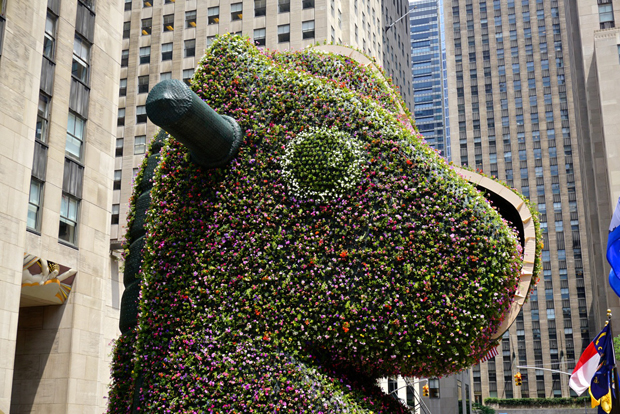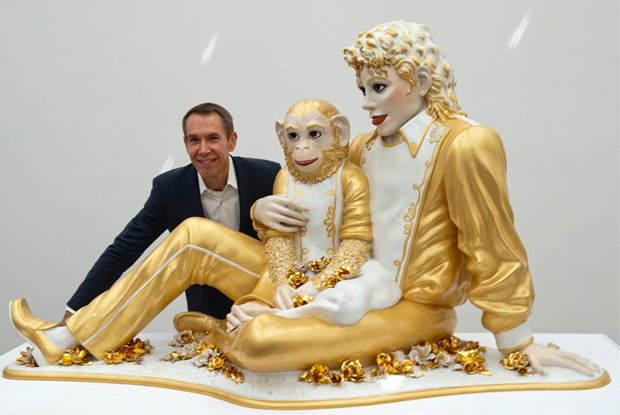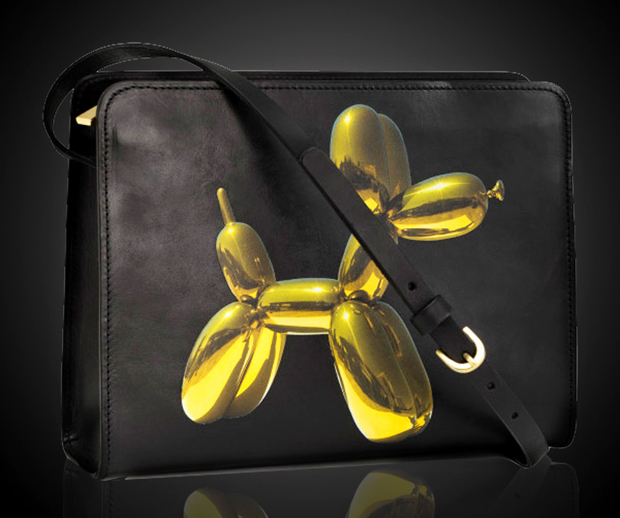
Does Jeff Koons still have the power to shock us?
Eileen Costello, author of our Brice Marden book, wonders whether the artist is still interested in dividing opinion
There's no doubting who is the biggest art world name in New York this summer. With his Split-Rocker planted form sprouting at Rockefeller Plaza until mid September and that major retrospective at the Whitney, not to mention the obligatory media coverage - not least in Vanity Fair, in which he poses naked in the gym, modesty protected by a careful use of typography, it is, quite simply, the summer of Koons - Jeff Koons.
But what do the cream of the art world's big brains, very many of them Phaidon authors, think about all this? We asked a few of them for their opinions and we'll be rolling out their own Koons controversies over the next few weeks.
We kick off the series with Eileen Costello, author of our fine Phaidon Focus book on Brice Marden. Our Focus series, as you doubtless know, serves as both a fine introduction into an artist's work as well as providing a strong insight, via Focus chapters, into the most important elements, stages and moments of their career. You can find the full print selection here and the digital versions here. Meanwhile, here's Eileen on Jeff.

When controversy fuels an artist’s work, can it continue to affront once the work gains public acceptance and is longer subject to critical beatings? At the Paris Salon of 1850–51, critics and public alike denounced Gustave Courbet (1819–1877) for having the temerity to depict ordinary people from his native village of Ornans. The following year he wrote to his parents, "When I stop being controversial, I'll stop being important."
Just over one hundred and fifty years later, Jeff Koons, who rose to art-star fame in the 1980s for producing work that has become as celebrated for its market value as its shock value is enjoying a largely positive critical response to his current retrospective at the Whitney Museum in New York.
As one critic noted, “It's much easier than ever to love his work, and him, than it is to hate him.” At one time the artist’s plastic flowers, Plexiglas-encased vacuum cleaners, and floating basketballs provoked hostility and created an uproar. Then came the sexually explicit paintings and sculptures depicting the artist with his then-wife, the Italian porn-star Ilona Staller, which were met with total incomprehension and outrage.
Now summer tourists are photographing themselves with Koons’s thirty-seven-foot-tall sculpture Split-Rocker (2000), a colossal and colorful topiary in the shape of a hobbyhorse’s split head, festooned with over 50,000 summer flowers, installed in the spot reserved for the annual Christmas tree at Rockefeller Center—as easily as they photograph themselves in Times Square with Elmo. Only a few blocks down Fifth Avenue at 48th Street, images of Koons’s yellow balloon-dog are soon scheduled to cover the six-story facade of H&M’s new flagship store alongside the phrase "Fashion Loves Art."

There one can purchase - while supplies last - a special-edition leather handbag emblazoned with the yellow balloon-dog sculpture that sold for a record-breaking $58.4 million at Christie’s in 2013. Downtown, at Astor Place, the gateway to New York’s increasingly gentrified East Village - where Koons had his first gallery exhibition in 1985 - Koons’s fourteen-foot-tall stainless steel Balloon Rabbit (Red) (2005–2010) currently resides in a glass-walled lobby of a newly constructed luxury high-rise, to the delight of passersby.
Courbet’s work met with universal praise at the 1870 Salon, by which time he had developed a circle of admirers and defenders, but until his dying day, the artist remained confrontational, producing one of his most provocative paintings, The Origin of the World, just ten years before his death. He is now recognized as one of the most innovative and influential artists of mid-nineteenth-century France. There's no debating Koons's originality, current popularity, or his influence on the art world, but with many more productive years ahead of him, it remains to be seen whether his penchant for producing divisive artwork is now behind him.
Look out for our next Jeff Koons story by David Carrier and Joachim Pissarro, co-authors of the very fine Wild Art book. And if you've enjoyed this insight into Jeff Koons check out Eileen's illuminating Phaidon Focus book on Brice Marden in print and on iBook. Meanwhile, we have a wonderful Courbet book here. And if you'd like to learn more about the exhibitions that made art history check out our books Salon to Biennial and Biennials and Beyond.